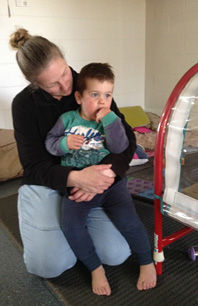

Connection
is everything
This year in The Nest we have focused on the relationships that the children have, and are building with the educators and their peers.
In the everyday curriculum we have been looking at helping children build relationships with one another by assisting them to deal with adversity.
Educators have used Marte Meo to help the children work through their emotions…

Marte Meo focuses on the importance of communication in the building of relationships and connections. When assisting children to work through their emotions, Marte Meo involves naming the child’s emotional or inner experiences.
MARTE MEO
Babies and toddlers have big emotions and when we name those emotions it tells them that they are not alone and that we are emotionally connected to them. This process then enables babies and toddlers to eventually develop words to describe their own emotional experiences.

Throughout the year, the children in The Nest have been exposed to unfamiliar materials such as clay and paint.
The children’s reactions during these experiences led us to have questions about babies’ interdependence and the factors that influence this interdependence.
We wondered whether it was the material itself or who was present for the experience that altered the babies confidence? Are the children more willing to participate when a peer has the confidence to explore this material first? These questions are what led to our project about babies interdependence using the Language of clay
We had previously set up clay on a table in the room.
The children were aware of the clay, however, educators noticed that there was no interest in touching the clay. The children moved away to other more familiar experiences.
The following day, the clay experience was set up on the floor with an educator present.
The results compared to the previous day were vastly different


The children were eager to enter the experience with an educator present.



As exposure to the new material grew, so did the children’s confidence. Within a week, they were squeezing, rolling and pressing their fingers into the clay
As the project progressed, educators noticed the children sharing their ideas through peer to peer scaffolding
Educator reflections:
The children relied on familiar educators to gain the confidence to explore unfamiliar materials
Once the children gained confidence they looked less to educators for guidance and more to the ideas that their peers expressed
The group looked for guidance from the children who were more comfortable with the clay, watching them intently and gaining confidence from this
The children require an educator to ‘be with them’ whilst they were exploring the unfamiliar experience
This project helped us to understand the importance of the Circle of Security in giving children a safe base when they are uncomfortable in unfamiliar situations
During the third and fourth terms, we had many new babies joining us in The Nest. This prompted us to think about our own practices and how we could better assist the children to settle into life at childcare. As educators, we strive to make the transition as calm as possible and give children a sense of belonging so they can engage in, and explore their environment confidently.
For this reason, The Nest team decided to conduct a whole room project looking at the Circle of Security.
Attachments with others is a crucial element of a child’s wellbeing. The secure attachments that children develop promote self-esteem and assist children in being able to better manage their emotions. In addition, children with secure attachments find it easier to form relationships with others.
The Circle of Security stems from this attachment theory, where children form secure and trusting relationships with adults which then gives them the confidence to explore their world in a positive way, knowing they have a secure base and safe haven to go to when needed.
Children require their exploration to be supported; however, they also need to be welcomed with open arms when necessary. It is so important to share joy with children, comfort and protect them and assist them to organize their feelings when needed.
Michelle filmed, photographed and reviewed educator practices with regards to the Circle of Security.
Helen looked at how educators can assist children to organize their feelings, and;
Courtney studied ways in which we can read the cues of children to better meet their needs.
We have made written observations, taken photos and videoed; drop-offs in the mornings, planned experiences and routine experiences. Throughout the project, we have looked at things from a child’s perspective…What do they require? How can we better meet individual needs and understand what those needs are? The following pages demonstrate the understandings educators have gained from a child’s perspective and the practices and strategies put in place to best support the children

'When you leave, I worry that you won’t come back. I am just learning that I will see you again'
Educators build secure relationships with children so they feel safe and supported whilst away from their families

When I can count on you, I learn to trust
Educators provide “safe hands” for children to come to so they feel there is a secure place to go when needed

the project showed us just how important it is to understand and implement the circle of security in our everyday practices and how it is essential that it guides our pedagogy. it is every child's right to be given this beginning as they enter into a world of uncertainty.
"No significant learning occurs without a significant relationship"
Dr James Comer


















